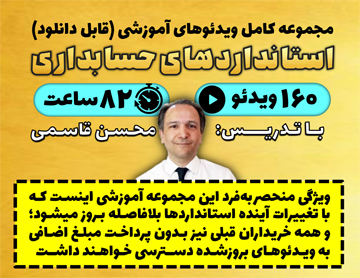دارایی نامشهود: یك دارایی قابل تشخیص غیرپولی و فاقد ماهیت عینی است. (استاندارد حسابداری 17 داراییهای نامشهود (تجدید نظر شده 1386 و اصلاح شده براساس استانداردهای حسابداری جدید تا مهر 1389)، استاندارد حسابداری 38 ترکیبهای تجاری (مصوب 1398))
ویژگیهای دارایی نامشهود
واحدهای تجاری معمولاً منابعی را صرف تحصیل، توسعه، نگهداری و بهبود داراییهای نامشهود از قبیل دانش فنی یا علمی، طراحی و اجرای سیستمهای جدید، حق امتیاز و علائم تجاری میكنند. نمونههای رایج از سرفصلهای كلی فوق، نرمافزار رایانهای، حق اختراع، حق تألیف، حق تكثیر یا نمایش فیلمهای سینمایی و ویدیویی، سرقفلی محل كسب (حقكسب یا پیشه یا تجارت)، حق استفاده از خدمات عمومی، حق امتیاز تولید یا خدمات است.
ماهیت غیر عینی
داراییهای نامشهود با تكیه بر ماهیت غیرعینی و غیرپولی آن تعریف میشود. بدین ترتیب اقلامی از قبیل حسابهای دریافتنی در زمره این داراییها قرار نمیگیرد.
برخی داراییهای نامشهود ممكن است بر روی یا در درون یک عنصر عینی از قبیل لوحهای فشرده (در مورد نرمافزار رایانهای)، مدارك قانونی (در مورد حق اختراع یا پروانه رسمی) یا فیلم باشد. در چنین شرایطی طبقهبندی قلم مزبور به عنوان دارایی ثابت مشهود یا دارایی نامشهود مستلزم قضاوت در باره این امر است كه كدام عنصر مهمتر است. مثلاً نرمافزار رایانهای مربوط به راهاندازی ماشینآلات، عملاً بخشی از ماشینآلات است و بنابراین در سرفصل داراییهای ثابت مشهود طبقهبندی میشود.
قابلیت تشخیص
طبق تعریف، دارایی نامشهود قابل تشخیص است، یعنی میتوان آن را از سرقفلی واحد تجاری متمایز كرد (از قبیل حق اختراع و حق تالیف). بدین ترتیب سرقفلی واحد تجاری كه از كل واحد تجاری یا سایر داراییهای واحد تجاری قابل تشخیص نیست به عنوان دارایی نامشهود شناسایی نمیشود، حتی اگر دارای منافع اقتصادی آتی باشد. منافع اقتصادی آتی ممکن است از همافزایی داراییهای قابل تشخیص تحصیل شده یا داراییهایی حاصل شود که به صورت جداگانه حائز معیارهای شناخت در صورتهای مالی نیستند. با این حال واحد تحصیلکننده مبالغی را بابت آنها در ترکیب تجاری میپردازد (سرقفلی ناشی از تركیب تجاری در استاندارد حسابداری شماره 19 مطرح شده است).
یک دارایی هنگامی معیار قابلیت تشخیص را در تعریف دارایی نامشهود احراز میکند که یکی از شرایط زیر را داشته باشد:
- الف. جدا شدنی باشد، یعنی بتوان آن را به منظور فروش، انتقال، اعطای حق امتیاز، اجاره یا مبادلـه (به صورت جداگانه یا همراه با یک قرارداد، دارایی یا بدهی مرتبط) از واحد تجاری جدا کرد، یا
- ب. از حقوق قراردادی یا سایر حقوق قانونی ناشی شود، صرف نظر از اینکه آیا چنین حقوقی قابل انتقال یا جدا شدنی از واحد تجاری یا سایر حقوق و تعهدات باشد یا خیر.
An intangible asset is an identifiable non‑monetary asset without physical substance - IAS 38 Intangible Assets & IFRS 3 Business Combinations
Intangible assets
Entities frequently expend resources, or incur liabilities, on the acquisition, development, maintenance or enhancement of intangible resources such as scientific or technical knowledge, design and implementation of new processes or systems, licences, intellectual property, market knowledge and trademarks (including brand names and publishing titles). Common examples of items encompassed by these broad headings are computer software, patents, copyrights, motion picture films, customer lists, mortgage servicing rights, fishing licences, import quotas, franchises, customer or supplier relationships, customer loyalty, market share and marketing rights.
Not all the items described in paragraph 9 meet the definition of an intangible asset, ie identifiability, control over a resource and existence of future economic benefits. If an item within the scope of this Standard does not meet the definition of an intangible asset, expenditure to acquire it or generate it internally is recognised as an expense when it is incurred. However, if the item is acquired in a business combination, it forms part of the goodwill recognised at the acquisition date (see paragraph 68).
Identifiability
The definition of an intangible asset requires an intangible asset to be identifiable to distinguish it from goodwill. Goodwill recognised in a business combination is an asset representing the future economic benefits arising from other assets acquired in a business combination that are not individually identified and separately recognised. The future economic benefits may result from synergy between the identifiable assets acquired or from assets that, individually, do not qualify for recognition in the financial statements.
An asset is identifiable if it either: (a) is separable, ie is capable of being separated or divided from the entity and sold, transferred, licensed, rented or exchanged, either individually or together with a related contract, identifiable asset or liability, regardless of whether the entity intends to do so; or (b) arises from contractual or other legal rights, regardless of whether those rights are transferable or separable from the entity or from other rights and obligations.
Control
An entity controls an asset if the entity has the power to obtain the future economic benefits flowing from the underlying resource and to restrict the access of others to those benefits. The capacity of an entity to control the future economic benefits from an intangible asset would normally stem from legal rights that are enforceable in a court of law. In the absence of legal rights, it is more difficult to demonstrate control. However, legal enforceability of a right is not a necessary condition for control because an entity may be able to control the future economic benefits in some other way.
Market and technical knowledge may give rise to future economic benefits. An entity controls those benefits if, for example, the knowledge is protected by legal rights such as copyrights, a restraint of trade agreement (where permitted) or by a legal duty on employees to maintain confidentiality.
An entity may have a team of skilled staff and may be able to identify incremental staff skills leading to future economic benefits from training. The entity may also expect that the staff will continue to make their skills available to the entity. However, an entity usually has insufficient control over the expected future economic benefits arising from a team of skilled staff and from training for these items to meet the definition of an intangible asset. For a similar reason, specific management or technical talent is unlikely to meet the definition of an intangible asset, unless it is protected by legal rights to use it and to obtain the future economic benefits expected from it, and it also meets the other parts of the definition.
An entity may have a portfolio of customers or a market share and expect that, because of its efforts in building customer relationships and loyalty, the customers will continue to trade with the entity. However, in the absence of legal rights to protect, or other ways to control, the relationships with customers or the loyalty of the customers to the entity, the entity usually has insufficient control over the expected economic benefits from customer relationships and loyalty for such items (eg portfolio of customers, market shares, customer relationships and customer loyalty) to meet the definition of intangible assets. In the absence of legal rights to protect customer relationships, exchange transactions for the same or similar non‑contractual customer relationships (other than as part of a business combination) provide evidence that the entity is nonetheless able to control the expected future economic benefits flowing from the customer relationships. Because such exchange transactions also provide evidence that the customer relationships are separable, those customer relationships meet the definition of an intangible asset.
Future economic benefits
The future economic benefits flowing from an intangible asset may include revenue from the sale of products or services, cost savings, or other benefits resulting from the use of the asset by the entity. For example, the use of intellectual property in a production process may reduce future production costs rather than increase future revenues.





دیدگاه خود را بنویسید